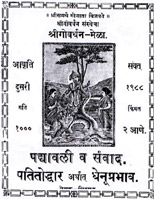

| • British view of the Ganpati Festival |
British view of the Ganapati Festival (contd...)
By mid - seventies there was a strong reaction against
the earlier head-long rush towards Westernism. The Hindu faith, till then
subjected to virulent attacks, specially by the Christian missionaries,
began to assert itself. The new reform movements that emerged - The Arya
Samaj, the Theosophical society, The Ramkrishna Mission -all contributed,
in their own ways, to the revival of the Hindu faith and culture. The
earlier, what may be called the "Liberal - rational" phase of the Indian
renaissance was now rapidly replaced by a new phase, which may be termed
as "emotional - revivalist" phase. The second phase of the renaissance
was marked by a "new note of assertive Hinduism" with its political counterpart,
Extremism.
 |
Tilak was the best representative of the second phase of the renaissance. He accurately judged the changing mood of the country. He knew that the complete rejection of the West was neither advisable nor possible. He appreciated the Western spirit of scientific inquiry, and himself later applied the Western methodology to his interpretation of Hinduism in his Gitarahasya. But at the practical and emotional level he wanted to use the newly- found religious fervour of the Hindus for ethical as well as political and patriotic purposes. For this, he could not have devised a more astute move than reviving public festival in honour of Ganesh, The most popular among the Hindus deities, especially in Maharashtra, and enlarging its scope for the political mobilization. |
A foreign scholar of the modern Indian History, has
neatly stated the rationale behind Tilak's choice of the deity, Ganesh,
for public celebrations:
The god (Ganesh) was a syncretistic figure, combining the elements of
high Hinduism, asceticism and wisdom, with the values of village (popular?)
Hinduism, devotion and pleasure. Unlike the popular regional god Vithal,
who was closely tied to the apolitical bhakti tradition, Ganapati had
links with the three broad traditions of Indian philosophy: devotion,
asceticism and action. Since one part of his personality is derived from
Shiva, the potent warrior, Ganapati had the potential for a political
career. As the "Overcomer of Obstacles", he was a useful symbol for a
protest movement.
The Ganapati festival was thus best calculated to lead the protest movement
by achieving the moral and political unity of all Hindus. Goldberg's observation
in this regard is noteworthy: "As Tilak saw it, this unity would, among
other things, safeguard the Hindu community against the further provocations
from the authorities and Moslem reactionaries. Besides, it was reckoned,
and not without ground, that in future the Moslem population too would
be able to take part in such a festival, since the Hindus in Maharashtra
towns readily participated in Moslem processions and pageants" during
the Muharram. Even the notorious sedition Committee Report (1918) writes
Goldberg, had to admit that the Ganesh festival was not intended to be
anti-Muslim and that Tilak "had from the very beginning attributed the
communal riots to the mischievous policy of the Government."
|
The ten- day reorganised public festival inaugurated in 1893 more than fulfilled Tilak's expectations. It made an intense apple to the popular imagination and the people from all strata of society religiously and freely participated in it. The grand occasion was used to organise lectures, processions, singing parties, melas and the theatrical performances. The melas, in particular, produced salutary impact on the large and eager audiences imbued with religious spirit. "The member of this melas", writes Edwardes, "were trained in the art of fencing with sticks and other physical exercises. During the ten-days of the festival, bands of young Hindus gave theatrical performances and sang religious songs, in which legends of Hindus mythology where skilfully exploited to arouse the hatred of the 'foreigner', the word mlenccha or 'foreigner' being applied to Europeans and Muhammadans. As the movement grew, leaflets were circulated, urging the Marathas to rebel as Shivaji did, and declaring that a religious out break should be the first step towards the overthrow of an alien rule". This account of the festival, though not entirely true, had much substance in it. The festival, as it was planned, became a powerful instrument for mass political education. From year to year the extent and grandeur of the ceremony increased with the result that it rapidly spread all over Maharashtra and some other parts of the Bombay Presidency. The district magistrate of Ahmadnagar reported in 1896: " the Ganapati movement is spreading; all most every town of any size in the district has its melas and Ganapatis now." The same was true of the other districts as well. |
